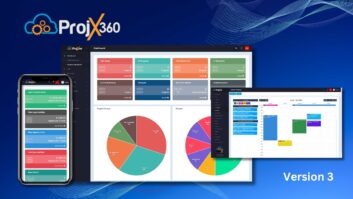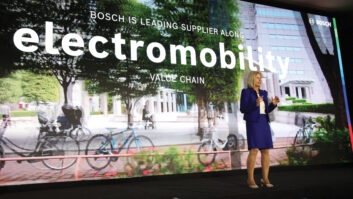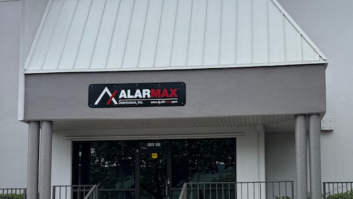For a product category set solidly in the high-end enthusiast range, significant attention is being given to promoting digital light processing (DLP) home theater projectors as more than a custom-install solution to home theater.
Indeed, many manufacturers and developers attending this week’s Cedia Expo are looking to promote DLP as a mid-range solution, with hopes that greater production volume will drive prices down and smaller, more portable product design choices will make DLP a more versatile option for home theater buffs.
Still, some manufacturers, like Runco International, state they are firmly dedicated to the custom install, high-end home theater market.
“There are a lot of companies that will be encouraging a plug-and-play approach,” said Sam Runco, founder and CEO of Runco International. “There is a customer out there who looks to do his own stuff, a lot of ‘do-it-yourselfers.’ But that’s not a Runco customer. The Runco customer is associated with a custom installer who can set up the product correctly for the end user. That maintains the credibility for us.”
Runco International will be showing its second generation — or “Gen 2” — products at CEDIA. Sam Runco wasn’t ready to disclose new product names at press time, but said the company will likely show five DLP products. “We’ll present two three-chip products and three one-chip products at the show,” he said. These Gen 2 products will keep the company in the forefront of DLP product development, he said. “What we’ve done up until now is taken DLPs and other fixed-pixel devices, which were perceived as being problematic, with the display itself seen as the bottleneck, and we worked on processing so image transitions would look smooth. We had an edge on the competition; we were ahead of the game on that point. Now the competition is coming out with good products and that will validate the marketplace, which will increase sales for everybody.”
Hoping to push DLP into a wider audience is chip developer Texas Instruments. “Our focus now for our rear-screen effort is to move those products closer to a mainstream price point,” said Gary Sextro, business manager for HDTV products in the DLP Group at T.I., maker of the Digital Micromirror Device (DMD), the semiconductor chip that is at the heart of DLP technology. “Our rear screens are fairly expensive right now. These are our OEMs’ premier products and we’d like to get volume increased. They are not really at the price point where we really want to be.”
To help increase awareness, for the first time T.I. will be running a DLP-specific course at CEDIA. “We need to clear misconceptions about the technology and educate the people who are selling it,” said Peter Broas, business manager for DLP portable entertainment products at T.I.
T.I.’s newest DMD chip, appearing in Sharp Electronics’ XV-Z9000U, is the first chip designed for a front-projection unit that is high definition capable with a 16:9 aspect ratio. It’s front projection that Broas and Sextro see eventually pushing DLP into the mainstream. Sextro also expects the changing form factor of DLP to have a huge impact on the market. “As this technology enables smaller and smaller projectors, it won’t be so much a fixed product that you install in one room, it will be something that you can move from room to room,” he said. “It will be like an appliance you can put in your bag, like a camera. We really want to create this new kind of instant gratification product.”
Bob Perry, Mitsubishi Consumer Electronics’ marketing director, said not to expect many new products at CEDIA this year compared to last year’s show. “But DLP has the potential to displace CRT in rear projection television,” he said. “Only recently has there been the 16:9 chip. At the show you’ll see ours, one from Hitachi and one from Panasonic. All three will be 16:9 and 720×1280. Plus you’ve got Sharp with its front projection. However, I believe ours (the WD-65100, $17,500 suggested retail) has what everybody will be looking for: lots of flexibility to handle different formats, and features like side-by-side, HD and PC images.”
Frank DeMartin, product marketing director for Sharp’s consumer electronics group, said the Z9000, first previewed at the 2001 CES, will be showcased in a home theater environment at CEDIA. “We’ll be showing some of the best of what’s possible now in consumer home theater,” DeMartin said. The XV-Z9000U is available at a suggested retail price of $10,995.95.
Single-chip DLPs are getting a lot of positive consideration from developers. “In our book, three-chip technology is outdated,” said Dan Drook, vice president of Sim2 Seleco. “All of our projectors are single chip. Everything we’ve launched this year and through the remainder of this year.” Sim2 will be showing an advanced prototype of its HT300, a 1280×720 HD compatible DLP projector with a target shipping date of Nov. 1. Pricing was not available by press time since the HT300 is still in a “beta phase.” “That seems to be what everybody looks for, the higher resolution,” Drook said. “That’s the buzz right now, but obviously each projector that we’ve brought has really its own story to tell as far as what the consumer wants —for example, the HT200DM (which stands for its dual mode resolutions of 800×600 and 848×480) is really built to maximize progressive scan DVD players.”
Marantz will be showing its VP-12S1 HD DLP Projector. The VP-12S1 incorporates three Faroudja decoder, line doubler and video enhancer chips, a high-definition 1280 x 780 pixel panel and newly developed Minolta custom optics. It has a 1000:1 contrast ratio, 700 ANSI lumens brightness, 3-2 pulldown detection, ultra-quiet operation and many additional enhancements. Suggested retail is $12,999.00.
Hitachi America’s Bill Whalen, senior product and marketing manager, said the 55DMX01W (suggested $12,995.99), first shown at CES in January, will be at CEDIA. It’s a one-chip, rear-screen model. “It has everything you’d expect in a high-end product,” Whalen said. “And we have the ability to go to 72hz, and none of the other DLP products in this class can do that. If you have a DVD player, like a PC DVD player, you can set its output to 72 frames per second.” Whalen also touted the device’s proprietary color wheel and built-in Dolby Digital processing. “It can almost stand alone as a home theater system.”
Panasonic will have it’s 52DL10 at the show. This DLP projector was announced at the NAB show this year. It’s suggested price is $10,000. Jonas Tanenbaum, national marketing manager for Panasonic’s display group, touted the 52DL10’s aesthetics as well as the technology. “Our DLP is a totally new, ground-up screen design,” he said. “We’ve been very satisfied with the DLP, fantastic resolution, the superior off-angle viewing.”
Zenith Electronics will be at CEDIA with its previously announced DXG-210, a DLP unit with a suggested $9,995 price tag. “We’re not a huge player in DLP,” said Bruce Messman, product manager, “but our strategy is to be the complete digital video solution source, so the DXG-210 rounds out our entire line.” The 210 features true XGA native resolution and compressed SXGA resolution as well as selectable 16:9 and 4:3 aspect ratios for the S-video and composite video inputs.













